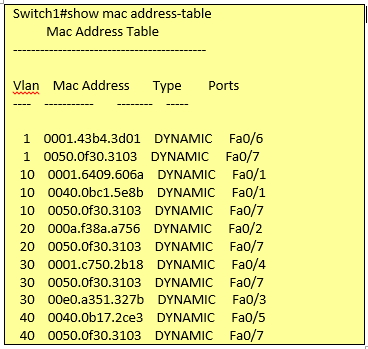Today’s CCENT & CCNA exam prep question will be on the topic of switching. We are going to teach you how to read exhibit outputs. Back in 1999 when I first took my CCNA exam, switching was only about 15% of the exam and the CCNA questions on switching were very easy. Simple things like “What are the three forwarding modes on a Cisco switch?” All you had to do was memorize cut-through, fragment-free and store and forward. But on today’s newly revised CCENT 100-101 and CCNA 200-120 exams Cisco has really upped the ante for you to obtain your CCNA certification. Now you really have to understand switching and how it works. For example, on today’s sample CCNA question you have to look at the output from a show mac address-table and be able to understand what it says. Then look at the output from a show cdp neighbors command and understand what that is telling you too. Then you have to combine what you were able to ascertain from both put together to answer the question. That is much more difficult than simply remembering a few forwarding modes!
So what we are going to do today is teach you how to read the outputs and how to apply it to the question. So take a look at each exhibit below. Then read the question and see if you can figure out the correct answer. If you are not able to at that point, we will give you the switching theory behind it and explain the output in detail. Then see if you can answer it correctly. If not, we will then give you the answer!
Refer to the exhibit of the show cdp neighbors output.

CCENT & CCNA show cdp neighbors output
Now also look at the show mac address-table output.

CCNA show mac output
Which three statements are true of the interfaces on Switch1? (Choose three)
A. Interface FastEthernet0/4 has been disabled.
B. hub is connected directly to FastEthernet0/1.
C. Multiple devices are connected directly to FastEthernet0/7.
D. FastEthernet0/8 is connected to a router.
E. FastEthernet0/7 is configured as a trunk link.
F. FastEthernet0/3 has statically assigned MAC addresses.
H. FastEthernet0/1 is connected to a host with multiple network interface cards.
Now hopefully you already know the answer to today’s CCENT/CCNA exam question. But if you do not, we are going to explain some of the theory behind it so you can put all of the pieces together. These are the types of questions you will see on the CCNA exam. So it is imperative you have lots of practice with these sort of questions. You have to remember that you only have a limited amount of time on the exam. So you can’t spend a couple of minutes on these sort of questions. You need practice, practice, practice like you can find in our CCENT and CCNA practice exam simulators. They are so good, they come with a Pass Guarantee! Here is a link to the CCNA Trial Practice Exam Simulator.
Theory
Now back to the theory on today’s certification exam question. We need to understand the theory behind how a switch operates and what you can glean from the mac address table and CDP output.
The exhibits show the output from the show mac address-table and the show cdp neighbors commands. Switches use MAC address tables to determine how to forward traffic between ports and information contained in them is learnt either dynamically or statically. Static mac address entries are mac addresses that have been statically configured while the dynamic mac addresses are addresses the switch learns from devices connected to its ports. The switches usually refreshes the mac address table every 300 seconds to check whether there are any changes to the ports.
CDP (CISCO Discovery Protocol) is a proprietary protocol used to discover CISCO devices which are directly connected.
Answers & Explanations
In this scenario, answer A is wrong since the mac address-table shows an entry for the port FastEthernet0/4
Answer B is correct since port FastEthernet0/1 is shown twice and on the same VLAN and therefore has to be connected to a hub or another layer 1 device.
FastEthernet0/7 has several VLANs but that does not mean it is mean it is an access port, trunk ports usually carry untagged traffic between layer 2 and layer 3 devices. This means that this port is a Trunk port as shown in answer E.
From the “show CDP neighbors” output above, port FastEthernet0/8 is shown to be a CISCO router.
Answer F is wrong since the port FastEthernet0/3 is shown clearly as dynamic in the mac address-table which means it has been learnt dynamically by the switch.
So the correct answers are B, D and E.
So how can you get this type of hands-on experience to make these sort of questions second nature? Simple! Have your very home home CCENT/CCNA home lab! There is no better way to learn then to actually be able to have some switches and routers connected together to see the actual CDP output from them. Then as you change the cabling around see how the output changes; or even if you put an interface in an administratively down state see the impacts. CCNA labs are very affordable now days. You can get a kit for as low at $129 with all the training material you need. So checkout the CCNA lab kits we offer CertificationKits CCNA Lab Kits and let us know if you have any questions on how to build your CCNA lab as we will be happy to help. Simply send us your question via the Contact Us form in the upper right of the site.
